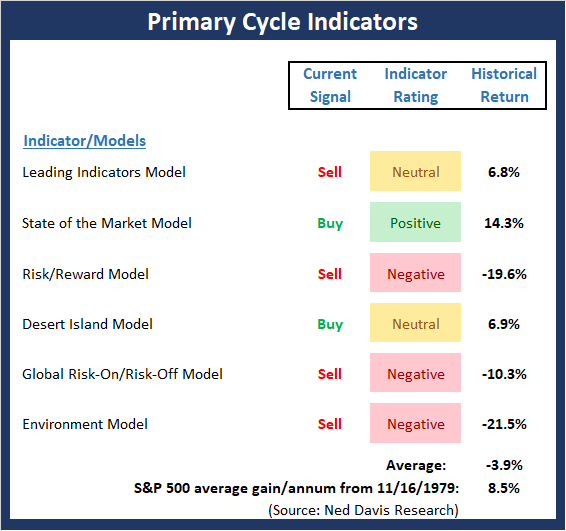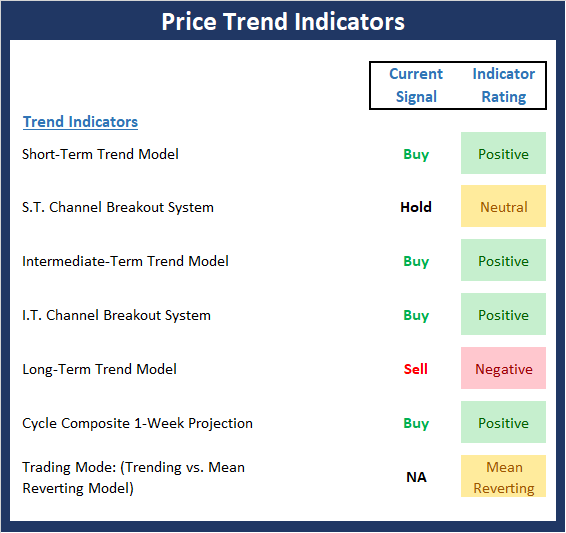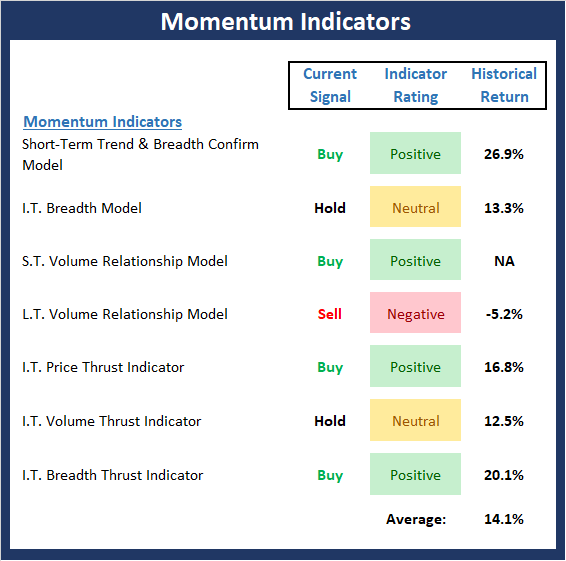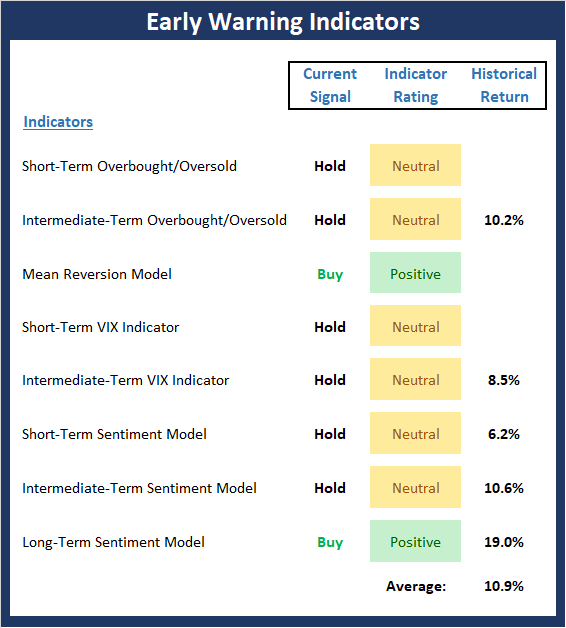To be sure, it is rare to see the mood of the market swing from the depths of despair seen on Christmas Eve to the "happy days are here again" feeling of last week in such a short period of time.
To review, starting December 3rd, stocks began moving down - in a straight line - with the S&P 500 falling -15.23% in just 15 days. Then, in an abrupt change of heart, the index rallied +13.59% in the ensuing 17 days. Talk about a mood swing!
So, over the 32 trading days spanning December 3, 2018 through January 18, 2019, the S&P 500 traveled a total of 28.8%, which is a pretty impressive feat. Oh, and in the process, the recent rally erased the vast majority of the December debacle. Wow.
Looking at the action from a longer-term perspective, we see that the S&P fell -19.8% from the high-water mark set on September 20, 2018 through December 24, 2018 - and has since proceeded to recover a little more than half of the overall decline.
S&P 500 - Weekly
View Larger Chart
Given the intensity of the relentless decline and then the impressive bounce to the upside, which wound up triggering some "breadth thrust" buy signals along the way, the question of the day is, what the heck is going on and where do we stand now?
Trying to predict what happens next in Ms. Market's game can be challenging at best. So, instead of attempting to guess what comes next, I have been focusing on getting a handle on the meaning of the recent action. My thinking is that if I can come to understand the "why" behind these volatile moves, I can then look at history to try and find similar situations, which, might provide a clue in terms of what to expect next.
Thus, the first question we need to get our arms around is...
Why The Decline?
As we've discussed a time or two already, I believe there were three primary drivers to the market's dance to the downside. First and foremost was the fear of a Fed "overshoot" - i.e. fear of the Fed tightening monetary conditions too far and pushing the economy into recession. And lest we forget, the Fed actually has a long history of doing just that.
Next, there was the fear that the President's trade war with China would become prolonged. The big fear was the tariffs, which, as the textbooks tell us, are really just a tax on consumption, would wind up counteracting the good stuff that the tax stimulus had provided and the U.S. economy would wind up in recession.
And finally, there was the fear that the slowdown of corporate earnings and global economic growth would wind up gaining momentum to the downside, with the end result being, yep, you guessed it; a recession in the U.S.
So, despite the economic models I follow suggesting very little chance of a recession occurring in the good 'ol USofA, the fear was that the end of the current economic expansion might be artificially induced by these "policy missteps." And with the yield curve inching ever closer to inversion, the really big fear was that our policymakers were about to shoot themselves in the economic foot.
All About Fear
To be clear, the common denominator to all three issues here is the word "fear." Not the fear of what was actually happening in the economy or in corporate America, but rather the fear of what "might" happen in the future. And in my experience, this is the worst kind of fear as it allows traders to extrapolate the worst without any pesky evidence to back up the trade.
In my humble opinion (and with the aid of a healthy dose of hindsight), it appears that the December drubbing was a classic example of a fear-based, panic event. Aka a market freak out. So, with no real news to refute the Negative Nancy narrative and the algos all doing the same thing at the same time, WHOOSH, down prices went.
A Possible Historical Reference
In looking back at the various declines I've been a part of since 1980, I find the environment that most closely resembles the current fear-based situation was that of 2011.
If you will recall, during the summer of 2011, markets were fretting mightily about several issues including the latest iteration of the Greece/European Banking Crisis and, perhaps more importantly, the rating downgrade of U.S. Government debt.
The key here was that, as I believe is also the case today, the fear of what "might" happen in response to these dueling debacles was the primary driver of the action. And while we all know that history never repeats exactly, it does, as the saying goes, oftentimes rhyme.
On that note, take a look at the chart below from Nautilus Investment Research comparing the 2011 market action (the black line) with the current movement of the S&P 500 (the red line).
While clearly not a perfect correlation match (79% to be exact, according to Nautilus), the price action does appear to be largely similar. Thus, I'm going to opine that we've got a possible historical "rhyme" going here - well, through 1/17/19 anyway.
For me, the key takeaway from this analysis is what happened next in 2011. To review, the market first declined on the fear of all the bad stuff that might happen. Then the downgrade news broke, and the market flushed lower. From there, the indices enjoyed a couple of bounces, which were followed by a series of "retests." Then eventually, the secular uptrend resumed - and the major stock market indices went on to new highs.
One of the key differences today is that we don't have a singular "event" that created what is known as a "bad news panic." No, what we have today is what I will call a "Trifecta of Fears," two of which are tied to decisions and the news.
The good news is that two of the fears appear to be "resolved" or are at least on their way to being resolved. Hence the bounce back in stock prices.
As everyone knows by now, the Fed appears to have gotten the message from the markets and has blinked. In short, traders expect the Fed to now be "on hold" with regard to their rate hiking campaign and to be reasonable regarding their ongoing balance sheet reduction plans.
In addition, based on the news flow, the market appears to be positioned for a trade deal to get done with China in the near-term.
From my seat, the resolution of these two fears "esplains" the 50% rebound in stock prices. The next question is, of course, where do we go from here?
Critical Juncture
As I pointed out on the chart above, it looks to me as if the market is currently at a critical juncture. As in, is it time for a retest phase or will the bulls simply continue to power ahead from a "V Bottom?" To help answer the question, I think it is important to note that there are a couple near-term deadlines that could help confirm the current narrative, which assumes that everything will be fine.
First up is this week's FOMC meeting. Nobody expects any movement on rates. But it is fair to say that traders DO expect the recent dovish commentary regarding both the path of rates and the balance sheet runoff to continue. Anything to the contrary could be greeted with selling.
Next up in the Captain Obvious category is the March 1 deadline for a deal to get done with China. Thus, the headlines here are likely to create some volatility between now and then as the administration continues to negotiate through the press. But the key is the market appears to be in the process of pricing in a positive outcome. And again, anything substantive to the contrary could be problematic.
And finally, there is the #GrowthSlowing issue, both in terms of earnings and GDP growth. So far, the current earnings parade is being viewed "pretty good" due to the fact that the results have not been as bad as feared. This may be due to the fact that the Consensus GAAP EPS Estimates for 2019 have been knocked down more than 10% from where they stood last summer ($171 versus $153 - source Ned Davis Research). Thus, it appears that analysts have been busy pricing in the slowdown.
For the record, the consensus estimate for S&P 500 GAAP EPS growth for 2019 currently stands at 9.9% and the consensus estimate for S&P Operating Earnings growth is at 8.1%. The question is if the estimates have been reduced enough to reflect reality. We shall see.
In addition, now that the government is up and running again (at least for a while, anyway), the flow of economic data will resume tout suite. From my seat, it is safe to say that each report will be heavily scrutinized and that any evidence suggesting that economic growth is slowing more than currently expected will be met accordingly.
The Takeaway
While merely one man's opinion on the subject, my takeaway from the recent market action is that the current rally has undone or "corrected" a healthy portion (50%) of the overall decline (or viewed another way, the entirety of December's drubbing) in response to the worries over the Fed and Trade being "solved" or, at the very least, reduced.
Going forward, I believe traders will be pricing in the issue of growth slowing. And for that we will need to see the data. Game on.
Weekly Market Model Review
Now let's turn to the weekly review of my favorite indicators and market models...
The State of the Big-Picture Market Models
I like to start each week with a review of the state of my favorite big-picture market models, which are designed to help me determine which team is in control of the primary trend.

View My Favorite Market Models Online
The Bottom Line:
- For the fourth week in a row, there is an important change on the Primary Cycle board - this time, positive. Last week, I wished for some green on the board in the Indicator Rating column. So, it is encouraging to seek the State of the Market Model - which measures the technical status of the primary cycle - move up into the positive zone. However, it is important to recognize that technical models have been "fooled" fairly often in recent years and that, overall, the board leaves a lot to be desired.
This week's mean percentage score of my 6 favorite models improved to 47.8% from 41.9% (2 weeks ago: 46.1%, 3 weeks ago: 40.3%, 4 weeks ago: 36.5%) while the median rose to 45% from 40% (2 weeks ago: 55%, 3 weeks ago: 50%, 4 weeks ago: 44%).
The State of the Trend
Once I've reviewed the big picture, I then turn to the "state of the trend." These indicators are designed to give us a feel for the overall health of the current short- and intermediate-term trend models.

View Trend Indicator Board Online
The Bottom Line:
- There can be little argument that the stock market's trend has improved as both the short- and intermediate-term trend models are now rated as positive. However, from a near-term perspective, prices appear to have paused. And from the long-term point of view, there remains a fair amount of work to do before the bulls can claim control of the game again.
The State of Internal Momentum
Next up are the momentum indicators, which are designed to tell us whether there is any "oomph" behind the current trend.

View Momentum Indicator Board Online
The Bottom Line:
- The Momentum board continues to improve as this week, the Short-Term Volume Relationship Indicator flashed a buy signal and improved to positive. And while the Long-Term Volume Relationship indicator has yet to do the same, the reading is very close to turning green. It is also worth noting that the average historical return of the board is now well above the historical norm.
The State of the "Trade"
We also focus each week on the "early warning" board, which is designed to indicate when traders might start to "go the other way" -- for a trade.

View Early Warning Indicator Board Online
The Bottom Line:
- Stocks remain overbought from a short-term perspective and as I mentioned last week, almost any decline will trigger a sell signal from our s.t. overbought/sold model. The bottom line remains the same; stocks are ripe for a pullback. However, it is also very important to remember that when a market reaches an overbought condition and then stays overbought for an extended period of time, it is a positive.
The State of the Macro Picture
Now let's move on to the market's "environmental factors" - the indicators designed to tell us the state of the big-picture market drivers including monetary conditions, the economy, inflation, and valuations.

View Environment Indicator Board Online
The Bottom Line:
- Despite the rather violent price action seen over the past few months, the External Factors board is actually in pretty good shape. And while I wouldn't call the current status of the board overwhelmingly bullish, green does appear to be the dominant color. As such, the odds would appear to favor the bulls from a macro perspective. However, the news cycle is likely to continue to drive the action from a near-term point of view.
Thought For The Day:
Not everything that counts can be counted, and not everything that can be counted, counts. -Albert Einstein
Wishing you green screens and all the best for a great day,

David D. Moenning
Founder, Chief Investment Officer
Heritage Capital Research
HCR Focuses on a Risk-Managed Approach to Investing
What Risk Management Can and Cannot Do
HCR Awarded Top Honors in 2018 NAAIM Shark Tank Portfolio Strategy Competition
Each year, NAAIM (National Association of Active Investment Managers) hosts a competition to identify the best actively managed investment strategies. In April, HCR's Dave Moenning took home first place for his flagship risk management strategy.
<hr>Disclosures
At the time of publication, Mr. Moenning held long positions in the following securities mentioned: None - Note that positions may change at any time.
Indicators Explained
Short-Term Trend-and-Breadth Signal Explained: History shows the most reliable market moves tend to occur when the breadth indices are in gear with the major market averages. When the breadth measures diverge, investors should take note that a trend reversal may be at hand. This indicator incorporates NDR's All-Cap Dollar Weighted Equity Series and A/D Line. From 1998, when the A/D line is above its 5-day smoothing and the All-Cap Equal Weighted Equity Series is above its 25-day smoothing, the equity index has gained at a rate of +32.5% per year. When one of the indicators is above its smoothing, the equity index has gained at a rate of +13.3% per year. And when both are below, the equity index has lost +23.6% per year.
Channel Breakout System Explained: The short-term and intermediate-term Channel Breakout Systems are modified versions of the Donchian Channel indicator. According to Wikipedia, "The Donchian channel is an indicator used in market trading developed by Richard Donchian. It is formed by taking the highest high and the lowest low of the last n periods. The area between the high and the low is the channel for the period chosen."
Intermediate-Term Trend-and-Breadth Signal Explained: This indicator incorporates NDR's All-Cap Dollar Weighted Equity Series and A/D Line. From 1998, when the A/D line is above its 45-day smoothing and the All-Cap Equal Weighted Equity Series is above its 45-day smoothing, the equity index has gained at a rate of +17.6% per year. When one of the indicators is above its smoothing, the equity index has gained at a rate of +6.5% per year. And when both are below, the equity index has lost -1.3% per year.
Cycle Composite Projections: The cycle composite combines the 1-year Seasonal, 4-year Presidential, and 10-year Decennial cycles. The indicator reading shown uses the cycle projection for the upcoming week.
Trading Mode Indicator: This indicator attempts to identify whether the current trading environment is "trending" or "mean reverting." The indicator takes the composite reading of the Efficiency Ratio, the Average Correlation Coefficient, and Trend Strength models.
Volume Relationship Models: These models review the relationship between "supply" and "demand" volume over the short- and intermediate-term time frames.
Price Thrust Model Explained: This indicator measures the 3-day rate of change of the Value Line Composite relative to the standard deviation of the 30-day average. When the Value Line's 3-day rate of change have moved above 0.5 standard deviation of the 30-day average ROC, a "thrust" occurs and since 2000, the Value Line Composite has gained ground at a rate of +20.6% per year. When the indicator is below 0.5 standard deviation of the 30-day, the Value Line has lost ground at a rate of -10.0% per year. And when neutral, the Value Line has gained at a rate of +5.9% per year.
Volume Thrust Model Explained: This indicator uses NASDAQ volume data to indicate bullish and bearish conditions for the NASDAQ Composite Index. The indicator plots the ratio of the 10-day total of NASDAQ daily advancing volume (i.e., the total volume traded in stocks which rose in price each day) to the 10-day total of daily declining volume (volume traded in stocks which fell each day). This ratio indicates when advancing stocks are attracting the majority of the volume (readings above 1.0) and when declining stocks are seeing the heaviest trading (readings below 1.0). This indicator thus supports the case that a rising market supported by heavier volume in the advancing issues tends to be the most bullish condition, while a declining market with downside volume dominating confirms bearish conditions. When in a positive mode, the NASDAQ Composite has gained at a rate of +38.3% per year, When neutral, the NASDAQ has gained at a rate of +13.3% per year. And when negative, the NASDAQ has lost at a rate of -12.29% per year.
Breadth Thrust Model Explained: This indicator uses the number of NASDAQ-listed stocks advancing and declining to indicate bullish or bearish breadth conditions for the NASDAQ Composite. The indicator plots the ratio of the 10-day total of the number of stocks rising on the NASDAQ each day to the 10-day total of the number of stocks declining each day. Using 10-day totals smooths the random daily fluctuations and gives indications on an intermediate-term basis. As expected, the NASDAQ Composite performs much better when the 10-day A/D ratio is high (strong breadth) and worse when the indicator is in its lower mode (weak breadth). The most bullish conditions for the NASDAQ when the 10-day A/D indicator is not only high, but has recently posted an extreme high reading and thus indicated a thrust of upside momentum. Bearish conditions are confirmed when the indicator is low and has recently signaled a downside breadth thrust. In positive mode, the NASDAQ has gained at a rate of +22.1% per year since 1981. In a neutral mode, the NASDAQ has gained at a rate of +14.5% per year. And when in a negative mode, the NASDAQ has lost at a rate of -6.4% per year.
Short-Term Overbought/sold Indicator: This indicator is the current reading of the 14,1,3 stochastic oscillator. When the oscillator is above 80 and the %K is above the %D, the indicator gives an overbought reading. Conversely, when the oscillator is below 20 and %K is below its %D, the indicator is oversold.
Intermediate-Term Overbought/sold Indicator: This indicator is a 40-day RSI reading. When above 57.5, the indicator is considered overbought and when below 45 it is oversold.
Mean Reversion Model: This is a diffusion model consisting of five indicators that can produce buy and sell signals based on overbought/sold conditions.
VIX Indicator: This indicator looks at the current reading of the VIX relative to standard deviation bands. When the indicator reaches an extreme reading in either direction, it is an indication that a market trend could reverse in the near-term.
Short-Term Sentiment Indicator: This is a model-of-models composed of 18 independent sentiment indicators designed to indicate when market sentiment has reached an extreme from a short-term perspective. Historical analysis indicates that the stock market's best gains come after an environment has become extremely negative from a sentiment standpoint. Conversely, when sentiment becomes extremely positive, market returns have been subpar.
Intermediate-Term Sentiment Indicator: This is a model-of-models composed of 7 independent sentiment indicators designed to indicate when market sentiment has reached an extreme from an intermediate-term perspective. Historical analysis indicates that the stock market's best gains come after an environment has become extremely negative from a sentiment standpoint. Conversely, when sentiment becomes extremely positive, market returns have been subpar.
Long-Term Sentiment Indicator: This is a model-of-models composed of 6 independent sentiment indicators designed to indicate when market sentiment has reached an extreme from a long-term perspective. Historical analysis indicates that the stock market's best gains come after an environment has become extremely negative from a sentiment standpoint. Conversely, when sentiment becomes extremely positive, market returns have been subpar.
Absolute Monetary Model Explained: The popular cliché, "Don't fight the Fed" is really a testament to the profound impact that interest rates and Fed policy have on the market. It is a proven fact that monetary conditions are one of the most powerful influences on the direction of stock prices. The Absolute Monetary Model looks at the current level of interest rates relative to historical levels and Fed policy.
Relative Monetary Model Explained: The "relative" monetary model looks at monetary indicators relative to recent levels as well as rates of change and Fed Policy.
Economic Model Explained: During the middle of bull and bear markets, understanding the overall health of the economy and how it impacts the stock market is one of the few truly logical aspects of the stock market. When our Economic model sports a "positive" reading, history (beginning in 1965) shows that stocks enjoy returns in excess of 21% per year. Yet, when the model's reading falls into the "negative" zone, the S&P has lost nearly -25% per year. However, it is vital to understand that there are times when good economic news is actually bad for stocks and vice versa. Thus, the Economic model can help investors stay in tune with where we are in the overall economic cycle.
Inflation Model Explained: They say that "the tape tells all." However, one of the best "big picture" indicators of what the market is expected to do next is inflation. Simply put, since 1962, when the model indicates that inflationary pressures are strong, stocks have lost ground. Yet, when inflationary pressures are low, the S&P 500 has gained ground at a rate in excess of 13%. The bottom line is inflation is one of the primary drivers of stock market returns.
Valuation Model Explained: If you want to get analysts really riled up, you need only to begin a discussion of market valuation. While the question of whether stocks are overvalued or undervalued appears to be a simple one, the subject is extremely complex. To simplify the subject dramatically, investors must first determine if they should focus on relative valuation (which include the current level of interest rates) or absolute valuation measures (the more traditional readings of Price/Earnings, Price/Dividend, and Price/Book Value). We believe that it is important to recognize that environments change. And as such, the market's focus and corresponding view of valuations are likely to change as well. Thus, we depend on our Valuation Models to help us keep our eye on the ball.
<hr>Disclosures
The opinions and forecasts expressed herein are those of Mr. David Moenning and may not actually come to pass. Mr. Moenning's opinions and viewpoints regarding the future of the markets should not be construed as recommendations. The analysis and information in this report is for informational purposes only. No part of the material presented in this report is intended as an investment recommendation or investment advice. Neither the information nor any opinion expressed constitutes a solicitation to purchase or sell securities or any investment program.
Any investment decisions must in all cases be made by the reader or by his or her investment adviser. Do NOT ever purchase any security without doing sufficient research. There is no guarantee that the investment objectives outlined will actually come to pass. All opinions expressed herein are subject to change without notice. Neither the editor, employees, nor any of their affiliates shall have any liability for any loss sustained by anyone who has relied on the information provided.
Mr. Moenning may at times have positions in the securities referred to and may make purchases or sales of these securities while publications are in circulation. Positions may change at any time.
The analysis provided is based on both technical and fundamental research and is provided "as is" without warranty of any kind, either expressed or implied. Although the information contained is derived from sources which are believed to be reliable, they cannot be guaranteed.
Investments in equities carry an inherent element of risk including the potential for significant loss of principal. Past performance is not an indication of future results.
Recent free content from FrontRange Trading Co.
-
 Is The Bull Argument Too Easy These Days?
— 8/31/20
Is The Bull Argument Too Easy These Days?
— 8/31/20
-
 What Do The Cycles Say About 2020?
— 1/21/20
What Do The Cycles Say About 2020?
— 1/21/20
-
 Modeling 2020 Expectations (Just For Fun)
— 1/13/20
Modeling 2020 Expectations (Just For Fun)
— 1/13/20
-
 Tips From Real-World Wendy Rhoades
— 5/06/19
Tips From Real-World Wendy Rhoades
— 5/06/19
-
 The Best Recession Ever!
— 4/29/19
The Best Recession Ever!
— 4/29/19




